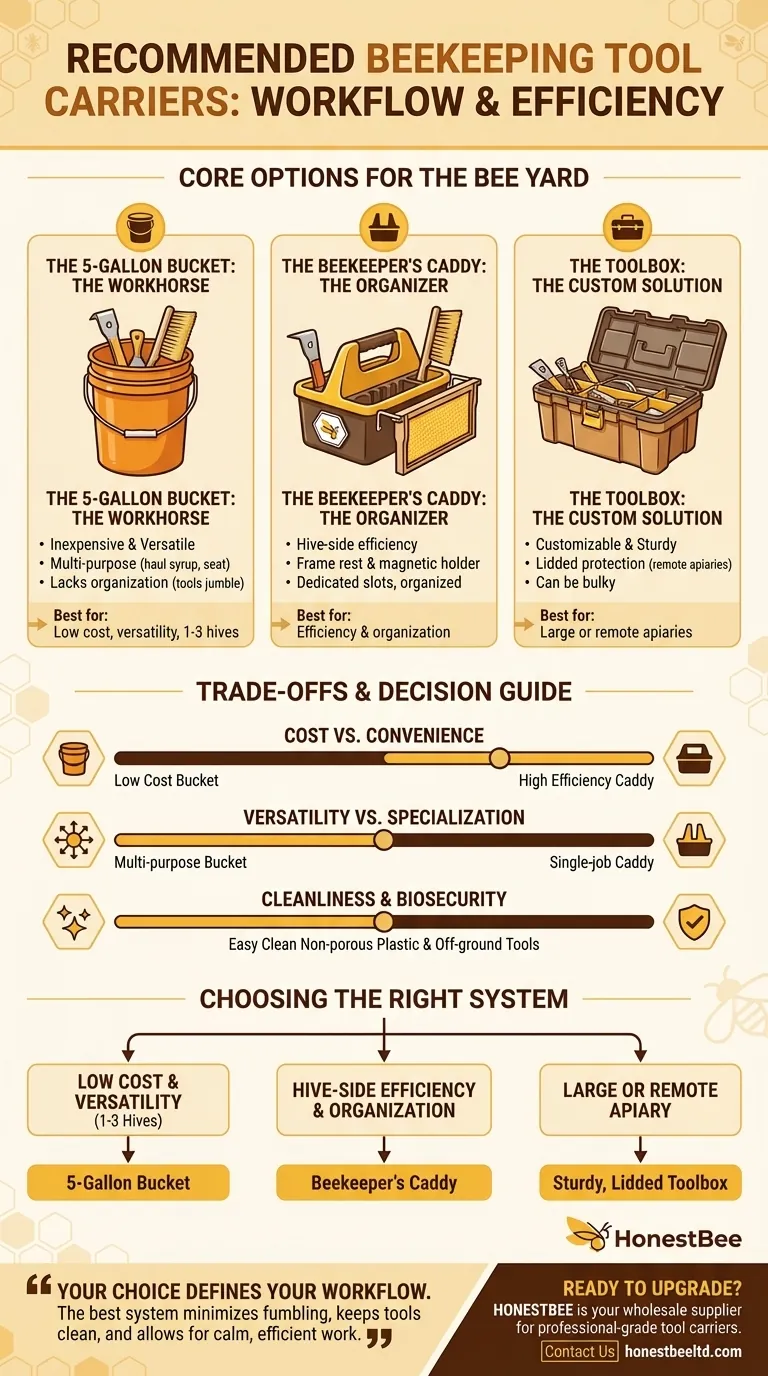For carrying your beekeeping tools, the most common and effective solutions are a simple 5-gallon bucket or a dedicated beekeeper's tool caddy. These options provide a stable, open-topped container that keeps your essential tools organized and immediately accessible while you work. Using the pockets on your bee suit is also a practical supplement for keeping one or two key items on your person.
Your choice of tool carrier is more than just a matter of transport; it defines your workflow at the hive. The best system is one that minimizes fumbling and keeps your tools clean and organized, allowing you to work calmly and efficiently, which in turn keeps your bees calmer.

Evaluating Your Core Options
The ideal tool carrier balances capacity, organization, and ease of use. While many containers can work, a few stand out for their practicality in the apiary.
The 5-Gallon Bucket: The Workhorse
A standard 5-gallon bucket is the quintessential entry-level tool carrier. It is inexpensive, widely available, and incredibly versatile.
Its primary strength is its multi-purpose nature. Besides carrying tools, it can be used to haul sugar syrup, collect burr comb, or even serve as a temporary seat.
The main drawback is a lack of built-in organization. Without inserts or modifications, tools tend to fall into a jumble at the bottom, forcing you to dig for what you need.
The Dedicated Beekeeper's Caddy: The Organizer
A purpose-built beekeeper's caddy or tote is designed specifically for hive-side efficiency. These often feature molded slots for hive tools, frame grips, and bee brushes.
Many models include a crucial frame rest, allowing you to hang a frame on the side of the hive body instead of placing it on the ground. Some also have a magnetic patch to hold your hive tool, keeping it secure and instantly accessible.
While more expensive, a dedicated caddy streamlines your movements and promotes a more professional, organized workflow.
The Simple Toolbox: The Custom Solution
A basic, open-topped toolbox or plastic bin offers a middle ground. They are often sturdier than a bucket and provide more structure.
You can customize a toolbox with dividers or magnetic strips to fit your specific toolset. Models with lids are also excellent for protecting your equipment from the elements, especially if you manage a remote apiary.
Their main disadvantage can be their bulk and weight, and they lack bee-specific features like a frame rest unless you add one yourself.
Understanding the Trade-offs
Choosing a system involves weighing practical considerations against your beekeeping style and the size of your operation.
Cost vs. Convenience
A 5-gallon bucket is the most budget-friendly option and is perfectly functional. However, the time saved and frustration avoided with a dedicated caddy's organizational features often provide a return on the higher initial investment, especially as you manage more hives.
Versatility vs. Specialization
The bucket's ability to serve multiple functions is a significant advantage, particularly for hobbyists with limited storage space. A specialized caddy does one job—organizing tools during an inspection—exceptionally well, but it does little else.
Cleanliness and Biosecurity
Regardless of your choice, the system must be easy to clean. Propolis, wax, and honey will accumulate on everything. A non-porous plastic bucket or caddy is easily scraped and washed, helping to prevent the potential spread of disease between hives. Keeping tools in a carrier and off the ground is a fundamental biosecurity practice.
Choosing the Right System for Your Apiary
Your ideal tool carrier depends on the scale of your operation and your primary goals as a beekeeper.
- If your primary focus is low cost and versatility (1-3 hives): Start with a 5-gallon bucket, perhaps adding a tool apron or organizer insert as you grow.
- If your primary focus is hive-side efficiency and organization: Invest in a dedicated beekeeper's caddy with a frame rest and magnetic holder.
- If your primary focus is managing a large or remote apiary: Use a sturdy, lidded toolbox to transport a larger set of tools and protect them from weather.
Ultimately, a well-organized tool system transforms hive inspections from a task into a calm, focused practice.
Summary Table:
| Tool Carrier | Best For | Key Features |
|---|---|---|
| 5-Gallon Bucket | Low cost, versatility (1-3 hives) | Inexpensive, multi-purpose, easily cleaned |
| Beekeeper's Caddy | Hive-side efficiency & organization | Frame rest, magnetic tool holder, dedicated slots |
| Toolbox | Large or remote apiaries | Customizable, lidded for protection, sturdy |
Ready to upgrade your beekeeping operation?
As a trusted wholesale supplier for commercial apiaries and equipment distributors, HONESTBEE provides the durable, professional-grade tool carriers and equipment that scale with your business. Let us help you equip your team for maximum efficiency and calm, productive hive inspections.
Contact HONESTBEE today to discuss your wholesale needs and discover our full range of beekeeping solutions.
Visual Guide

Related Products
- Professional Stainless Steel Pry-Bar Hive Tool
- Professional Multi-Function Stainless Steel Hive Tool
- Multi-Function Plier-Style Frame Grip Hive Tool
- HONESTBEE Professional Long Handled Hive Tool with Precision Cutting Blade
- HONESTBEE Advanced Ergonomic Stainless Steel Hive Tool for Beekeeping
People Also Ask
- What are the parts of a hive tool? Master Your Hive Inspections with the Right Tool
- What equipment and implements are needed by beekeepers besides the hives? Build Your Essential Beekeeping Toolkit
- What additional safety equipment should beekeepers use? Essential Tools for Hive Management
- What safety precautions are advised for beekeeping with hive tools? Master Safe Handling for Calm, Efficient Hives
- What is the correct method for lifting frames with a hive tool? Master the Technique for a Calm Hive



















